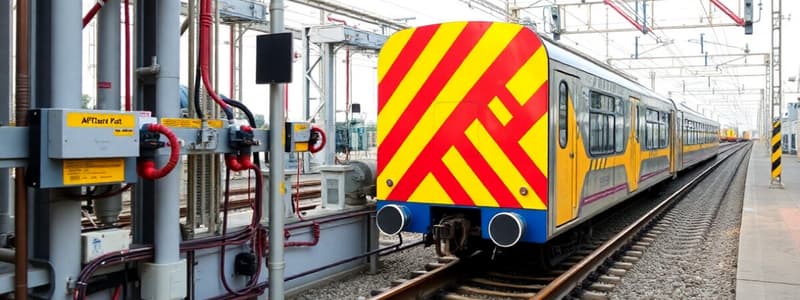Podcast
Questions and Answers
What is a primary factor that limits the maximum length of a track circuit in end fed mode?
What is a primary factor that limits the maximum length of a track circuit in end fed mode?
- Surface material of the track
- Number of trains using the track
- Ballast resistance (correct)
- Temperature fluctuations
What type of rail is reserved for traction return current in single rail DC track circuits?
What type of rail is reserved for traction return current in single rail DC track circuits?
- Insulated rail
- Conductive rail
- Uninsulated rail (correct)
- End fed rail
Why should connections from the O.H.E. mast only be made to the uninsulated rail?
Why should connections from the O.H.E. mast only be made to the uninsulated rail?
- To prevent shorting with insulated rails (correct)
- To allow for easier maintenance
- To improve rail bonding
- To enhance signal strength
In a situation where O.H.E. masts are not consistently on the same side, what precaution should be taken?
In a situation where O.H.E. masts are not consistently on the same side, what precaution should be taken?
What is the maximum recommended interval for cross-bonding uninsulated rails in single rail track circuits?
What is the maximum recommended interval for cross-bonding uninsulated rails in single rail track circuits?
What should be implemented on uninsulated rail at either end of a track circuit that is less than 100 meters?
What should be implemented on uninsulated rail at either end of a track circuit that is less than 100 meters?
What configuration can track circuits that use electric separation joints adopt?
What configuration can track circuits that use electric separation joints adopt?
What should be avoided when using single rail track circuits to prevent heavy currents during breaks?
What should be avoided when using single rail track circuits to prevent heavy currents during breaks?
What is a necessary measure for adjacent track circuits?
What is a necessary measure for adjacent track circuits?
Which type of relays should be used in AC traction areas?
Which type of relays should be used in AC traction areas?
Which statement is true regarding the application of AFTC?
Which statement is true regarding the application of AFTC?
What is the maximum length of a DC track circuit when using QBAT relays?
What is the maximum length of a DC track circuit when using QBAT relays?
What is the maximum catenary current allowed on a single track section for a standard DC track circuit?
What is the maximum catenary current allowed on a single track section for a standard DC track circuit?
What happens to the length of the DC track circuit when using concrete sleepers?
What happens to the length of the DC track circuit when using concrete sleepers?
What voltage is required for the operation of a track circuit using QBAT relays?
What voltage is required for the operation of a track circuit using QBAT relays?
What is an interim measure for the DC track circuit length under higher catenary current?
What is an interim measure for the DC track circuit length under higher catenary current?
What is the maximum allowable stray DC current for a track circuit length of less than 100 meters?
What is the maximum allowable stray DC current for a track circuit length of less than 100 meters?
What type of circuit is recommended when DC stray current exceeds the specified limits?
What type of circuit is recommended when DC stray current exceeds the specified limits?
Where should impedance bonds be placed in double rail track circuits?
Where should impedance bonds be placed in double rail track circuits?
What is the maximum allowable stray DC current for a track circuit that is 100 meters or longer?
What is the maximum allowable stray DC current for a track circuit that is 100 meters or longer?
What should not be connected to either rail in double rail track circuits?
What should not be connected to either rail in double rail track circuits?
What is required for Audio Frequency Track Circuits to ensure both rails are balanced?
What is required for Audio Frequency Track Circuits to ensure both rails are balanced?
Which type of impedances are required on 50 Hz electrified lines?
Which type of impedances are required on 50 Hz electrified lines?
What integrity check should Electric Traction Units undergo before service?
What integrity check should Electric Traction Units undergo before service?
What is the maximum voltage that track/traction return network components should not exceed under normal traction load conditions?
What is the maximum voltage that track/traction return network components should not exceed under normal traction load conditions?
Which objective is NOT related to track bonding?
Which objective is NOT related to track bonding?
In planning for track bonding, what must be indicated on the base plans provided to the signal department?
In planning for track bonding, what must be indicated on the base plans provided to the signal department?
What must be series bonded to prevent wrong side failure of the track circuit?
What must be series bonded to prevent wrong side failure of the track circuit?
What type of bonding arrangement must be in place to minimize the risk of loss of train shunt?
What type of bonding arrangement must be in place to minimize the risk of loss of train shunt?
Which department is responsible for indicating the position of insulated joints and impedance bonds on the electrification plans?
Which department is responsible for indicating the position of insulated joints and impedance bonds on the electrification plans?
Why is it essential for the traction return rail not to be series bonded?
Why is it essential for the traction return rail not to be series bonded?
What voltage must the components of the track/traction return network meet under traction short circuit conditions?
What voltage must the components of the track/traction return network meet under traction short circuit conditions?
What is a primary design consideration for AC impedance bonds?
What is a primary design consideration for AC impedance bonds?
Which statement about impedance bonds is accurate?
Which statement about impedance bonds is accurate?
What material should cables used between impedance bonds across IRJ be sheathed with?
What material should cables used between impedance bonds across IRJ be sheathed with?
Who is responsible for the maintenance of connections between rails and impedance bonds?
Who is responsible for the maintenance of connections between rails and impedance bonds?
What must be installed and maintained on the center tap of impedance bonds?
What must be installed and maintained on the center tap of impedance bonds?
What must the design and installation of impedance bonds consider regarding track maintenance?
What must the design and installation of impedance bonds consider regarding track maintenance?
Which statement is true regarding traction return bonding?
Which statement is true regarding traction return bonding?
What is the continuous current capacity required for AC impedance bonds?
What is the continuous current capacity required for AC impedance bonds?
What is the maximum interval at which cross bonding should be provided on uninsulated rails in single rail track circuits?
What is the maximum interval at which cross bonding should be provided on uninsulated rails in single rail track circuits?
What must be done if a track circuit is less than 100 meters in length?
What must be done if a track circuit is less than 100 meters in length?
What is the purpose of the continuous earth wire provided on traction masts in single line track circuited sections?
What is the purpose of the continuous earth wire provided on traction masts in single line track circuited sections?
What type of bond must be specially installed in double rail track circuits for connections to earth wires?
What type of bond must be specially installed in double rail track circuits for connections to earth wires?
What materials can be used for bonding rail joints in track circuited areas?
What materials can be used for bonding rail joints in track circuited areas?
Who is responsible for the installation and maintenance of rail joint bonds?
Who is responsible for the installation and maintenance of rail joint bonds?
What is the purpose of bonding the two rails of a non-track circuited track immediately after block joints?
What is the purpose of bonding the two rails of a non-track circuited track immediately after block joints?
What is the requirement for longitudinal bonding on a non-track circuited track adjacent to a track circuit?
What is the requirement for longitudinal bonding on a non-track circuited track adjacent to a track circuit?
Flashcards
Maximum Track Circuit Length
Maximum Track Circuit Length
The maximum length of a track circuit is determined by factors like ballast resistance, frequency, track layout, and the vendor (AFTC). It's generally limited to 700 meters in end-fed mode.
AFTC Use Restriction
AFTC Use Restriction
Automatic Train Control Function (AFTC) is not for new track construction. Existing AFTC systems should be maintained.
Single Rail DC Track Circuit
Single Rail DC Track Circuit
In this track circuit configuration, one rail is reserved for traction return current (uninsulated rail). All overhead line connections and return current connections go to this uninsulated rail.
Uninsulated Rail
Uninsulated Rail
Signup and view all the flashcards
OHE Mast Connection
OHE Mast Connection
Signup and view all the flashcards
Cross-Bonding
Cross-Bonding
Signup and view all the flashcards
AC Track Circuit configuration options
AC Track Circuit configuration options
Signup and view all the flashcards
Maintenance Schedule
Maintenance Schedule
Signup and view all the flashcards
Track Circuit Length (DC)
Track Circuit Length (DC)
Signup and view all the flashcards
Return Rail Staggering
Return Rail Staggering
Signup and view all the flashcards
AC Immunity in Track Relays
AC Immunity in Track Relays
Signup and view all the flashcards
Track Circuit Length Restriction
Track Circuit Length Restriction
Signup and view all the flashcards
QTA 2 Relay
QTA 2 Relay
Signup and view all the flashcards
Concrete Sleeper Restriction
Concrete Sleeper Restriction
Signup and view all the flashcards
QBAT Relay
QBAT Relay
Signup and view all the flashcards
Double Track Section Chokes
Double Track Section Chokes
Signup and view all the flashcards
Audio Frequency Track Circuit (AFTC) Amperage Limits
Audio Frequency Track Circuit (AFTC) Amperage Limits
Signup and view all the flashcards
Stray DC Current Measurements (AC Electrified Areas)
Stray DC Current Measurements (AC Electrified Areas)
Signup and view all the flashcards
Stray DC Current Limit (Short Track)
Stray DC Current Limit (Short Track)
Signup and view all the flashcards
Stray DC Current Limit (Long Track)
Stray DC Current Limit (Long Track)
Signup and view all the flashcards
Impedance Bonds (Double Rail AFTC)
Impedance Bonds (Double Rail AFTC)
Signup and view all the flashcards
AFTC Configuration
AFTC Configuration
Signup and view all the flashcards
Impedance Bonds for AFTC
Impedance Bonds for AFTC
Signup and view all the flashcards
Impedance Bond Traction Current Rating
Impedance Bond Traction Current Rating
Signup and view all the flashcards
AC Impedance Bond Rating
AC Impedance Bond Rating
Signup and view all the flashcards
IRJ Lead Cable Material
IRJ Lead Cable Material
Signup and view all the flashcards
Impedance Bond Safety
Impedance Bond Safety
Signup and view all the flashcards
S&T Department Responsibility
S&T Department Responsibility
Signup and view all the flashcards
Electrical Department Responsibility
Electrical Department Responsibility
Signup and view all the flashcards
Track Circuit Integrity
Track Circuit Integrity
Signup and view all the flashcards
RDSO Guidelines
RDSO Guidelines
Signup and view all the flashcards
Cross-Bonding in Single Rail
Cross-Bonding in Single Rail
Signup and view all the flashcards
Bonding on Single Line Track
Bonding on Single Line Track
Signup and view all the flashcards
Bonding in Double Rail Track Circuits
Bonding in Double Rail Track Circuits
Signup and view all the flashcards
Impedance Bond in Double Rail
Impedance Bond in Double Rail
Signup and view all the flashcards
Rail Joint Bond
Rail Joint Bond
Signup and view all the flashcards
Rail Bond Installation
Rail Bond Installation
Signup and view all the flashcards
Longitudinal Bonding Extension
Longitudinal Bonding Extension
Signup and view all the flashcards
Bonding in Non-Track Circuited Areas
Bonding in Non-Track Circuited Areas
Signup and view all the flashcards
Track Bonding Objectives
Track Bonding Objectives
Signup and view all the flashcards
Track Bonding Planning
Track Bonding Planning
Signup and view all the flashcards
Single Rail Track Circuit Bonding
Single Rail Track Circuit Bonding
Signup and view all the flashcards
Traction Return Rail Bonding
Traction Return Rail Bonding
Signup and view all the flashcards
Track Circuit Rail
Track Circuit Rail
Signup and view all the flashcards
Insulated Joints
Insulated Joints
Signup and view all the flashcards
Bonding Disconnection
Bonding Disconnection
Signup and view all the flashcards
Track Circuit Bonding
Track Circuit Bonding
Signup and view all the flashcards
Study Notes
Track Circuit Length Limitations
- Maximum track circuit length depends on various factors, including ballast resistance, frequency, layout, and the Automatic Train Control Function (AFTC) vendor.
- Length is generally limited to 700 meters in end-fed mode.
- Existing AFTC systems should be maintained.
- New AFTC systems are not to be used for new works.
DC Track Circuits in Restricted Areas
- AC electrified track circuits can utilize insulated rail joints (IRJs) or electrical separation joints (ESJs) for configuration as single or double rail sections.
- Electric separation joints (ESJs) configure track circuits only as double rail.
Single Rail DC Track Circuits
- In single rail circuits, one rail is reserved for traction return current (the uninsulated rail).
- Connections to overhead line equipment (O.H.E.) masts, feeding points, and booster transformers are made to the uninsulated rail.
- The rail adjacent to the O.H.E. mast is preferably used as the uninsulated rail, but other configurations may be necessary in yards with many points, crossings, or staggered track circuits.
- Electrical department precautions (insulating sleeves, clearances) prevent short circuits when configurations are not ideal (e.g., O.H.E. masts are not on the same side of the track).
- For single rail circuits, adjacent track uninsulated rails must be cross-bonded every 100 meters (or at either end if the track is less than 100 meters). This prevents excessive current flow if an uninsulated rail section breaks.
Track Circuit Relay Protection
- AC-immune relays must be used in AC traction areas.
- Track circuit relays require protection from interfering voltages (longitudinal voltage).
- This interference depends on traction return current and the return rail's impedance.
- Wheel sets at different positions on the track create interfering voltages that influence the relay.
DC Track Circuit Length Restrictions
- DC track circuit length is limited by the return current (300 amperes per single-track and 600 amperes per double track).
- Factors like relay type and sleeper type can also affect maximum circuit length.
- Circuit length extension is possible with specific relay types up to 450 meters.
- Ballast resistance can relax length restrictions using specific technology (PCSTE).
Audio Frequency Track Circuits (RE Area)
- In double rail track circuits, impedance bonds are necessary at insulated rail joints (IRJs) to handle traction return current.
- Overhead electrical equipment (O.H.E.) masts cannot be connected to either of the rails in a double rail circuit. These masts require separate grounding.
- Connections for feeding points and booster transformers must connect to center points of impedance bonds.
- Only approved audio frequency circuits can be used.
- The audio frequency track circuit must have balanced current return pathways on each track rail (relative to Earth and each other).
- Impedance bonds compensate when traction return current is not adequately balanced in the track circuit design.
- Track circuits must be examined for harmonic generation before commissioning.
Impedance Bonds in Restricted Areas (RE)
- Impedance bonds for 50 Hz electrified systems must meet specific requirements (e.g., type approval).
- Impedance bonds can handle DC return currents, but these are generally higher current carrying capacity than AC designed bonds.
- Though impedance bonds can handle AC, their design should not compromise safety mechanisms for personnel working on tracks.
- Bonds should connect across insulated rail joints.
- Bonds must accept 1000A current peaks for 5 minutes without overheating/damage.
- Leads linking impedance bonds must handle the total DC return current.
Track Bonding in Restricted Areas (RE)
- Track bonding provides a low-impedance path for traction return current, keeping components below safety voltage limits.
- Track bonding must support protective systems.
- Correct bonding design and installation minimize track circuit damage.
- Planning/diagram creation (electrical department, signal department, and communication/maintenance departments) for bonding location.
- Track track circuits and continuity bonds are included in plans for electrical system elements.
- Bonding for single rail systems (using series bonds) avoids system failure during a disconnection.
- Cross-bonding for single rail track circuits prevents excessive current flow if an uninsulated rail breaks (during single rail circuits only).
Studying That Suits You
Use AI to generate personalized quizzes and flashcards to suit your learning preferences.




